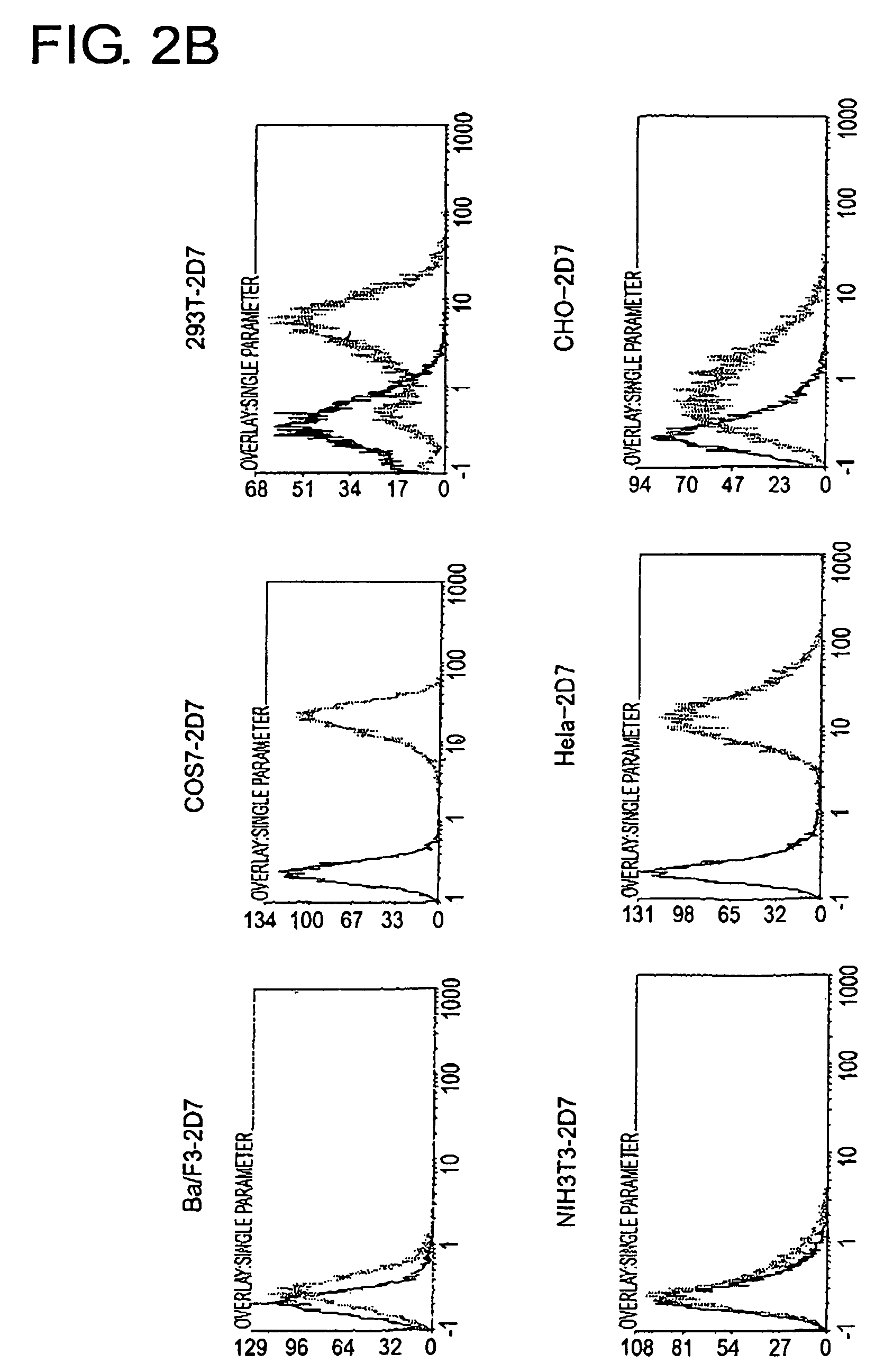Cell death-inducing agent
a cell death and inducing agent technology, applied in the field of cell death inducing agents, can solve the problems of difficult clinical application of 2d7 antibody to tumors or autoimmune diseases, diabody hardly acted on normal peripheral blood-derived lymphocytes and adherent cells, etc., and achieve the effect of large effect on activated t cells
- Summary
- Abstract
- Description
- Claims
- Application Information
AI Technical Summary
Benefits of technology
Problems solved by technology
Method used
Image
Examples
example 1
Expression Analysis of 2D7 Antigen in Each Type of Cell Line
[0162]To determine the cell line that should become the source to produce a cDNA expression library and the cell line that should become the host, 2D7 antigen expression in each type of animal cell was analyzed using FACS (FIG. 2A and FIG. 2B). As a result, among human-derived white blood cells, extremely strong expression of the 2D7 antigen was observed in lymphocytic tumor cell lines, RPMI8226, U266, and in Jurkat, but expression was found to be weak in K562. In Ba / F3, FDC-P1, and HCI-16, which are white blood cells derived from mice, expression was very weak, perhaps due to differences between the species. Of the adherent cells, expression was observed in COS7, 293T, and HeLa Expression was hardly observed in mouse NIH3T3 cells.
[0163]From the expression patterns mentioned above, RPMI8226 cells were judged to be appropriate as a source of a cDNA library to be used for expression cloning, and NIH3T3 cells were determined t...
example 2
[0164]Cell lysates were prepared from RPMI8226 cells and U266 cells, which express the 2D7 antigen, and NIH3T3 cells, which do not express the 2D7 antigen, and immunoprecipitation was performed using the 2D7 antibody. As a result, a molecule (approximately 12 kD) that precipitates specifically in RPMI8226 and U266 cells was observed (FIG. 3). This molecule was not detected by Western blotting using the 2D7 antibody, but since it is at least reproducibly precipitated by the 2D7 antibody, it was strongly predicted to be the 2D7 antigen itself, or a molecule that co-precipitates with the 2D7 antigen.
[0165]Coomassie staining was performed on this band; it was then cut out and the peptides were sequenced. As a result, this 12 kD molecule was identified as β2 microglobulin (β2M). Since β2M is one of the class I MHC protein complexes that associate with HLA class I through non-covalent bonds, the 2D7 antibody is considered to have co-precipit...
example 3
Examination of Growth Inhibitory Effect
[0172]Several types of leukemia cell lines (K562, Jurkat, and RPMI8226) were used to investigate whether the 2D7 antibody has a cytocidal effect. The expression level of the 2D7 antigen in the three cell lines is: K562, weakly positive; Jurkat and RPMI8226, strongly positive.
[0173]K562 and Jurkat cells were plated in the presence or absence of PHA and PMA, and 10 μg / ml of the 2D7 antibody was added thereto. On observing the cells 24 hours later, weakly 2D7-positive K562 cells did not show obvious differences in their morphology due to the presence or absence of the 2D7 antibody, however, addition of 2D7 antibody resulted in significant cell aggregation in Jurkat cells strongly expressing 2D7 (FIG. 7B and FIG. 7C). However, growth inhibition due to addition of the 2D7 antibody was not observed (FIG. 7A). Growth inhibition due to 2D7 in Jurkat cells activated by PHA and PMA stimulation was also not observed.
[0174]Unexpectedly, addition of 2D7 ant...
PUM
| Property | Measurement | Unit |
|---|---|---|
| temperature | aaaaa | aaaaa |
| temperature | aaaaa | aaaaa |
| body weight | aaaaa | aaaaa |
Abstract
Description
Claims
Application Information
 Login to View More
Login to View More - R&D
- Intellectual Property
- Life Sciences
- Materials
- Tech Scout
- Unparalleled Data Quality
- Higher Quality Content
- 60% Fewer Hallucinations
Browse by: Latest US Patents, China's latest patents, Technical Efficacy Thesaurus, Application Domain, Technology Topic, Popular Technical Reports.
© 2025 PatSnap. All rights reserved.Legal|Privacy policy|Modern Slavery Act Transparency Statement|Sitemap|About US| Contact US: help@patsnap.com



